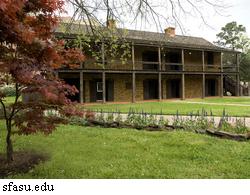Nacogdoches County is located in the heart of Deep East Texas along the Angelina River and Attoyac Bayou in the Piney Woods. The county seat and biggest city is Nacogdoches. Nacogdoches County has a rich history of Native Indian tribes like the Caddos and Hasinais. Spanish and French leaders originally inhabited the land that became Nacogdoches County in the sixteenth and seventeenth centuries. After several skirmishes with the Mexican Government, the Texas Legislature formed Nacogdoches County in June 1837.
During the 1840s and 1850s, the Old San Antonio Road  and Angelina River connected Nacogdoches farmers with other cities and counties. Farmers and merchants sold clothing, corn, wheat, sugar, and cotton. Citizens of the county voted for secession and joined the Confederacy. After the war, the county's economy suffered because of a devalued currency and unstable market. Once the economy recovered in the 1870s, farmers and families returned to growing, barley, wheat, cotton.
and Angelina River connected Nacogdoches farmers with other cities and counties. Farmers and merchants sold clothing, corn, wheat, sugar, and cotton. Citizens of the county voted for secession and joined the Confederacy. After the war, the county's economy suffered because of a devalued currency and unstable market. Once the economy recovered in the 1870s, farmers and families returned to growing, barley, wheat, cotton.
The railroad industry proved to be a valuable method of transportation and source of income through trading. During this time, sharecroppers and tenant farmers cultivated corn and cotton coming into the Great Depression. Cotton, oil and petroleum created more jobs and stabilized the economic infrastructure. From the end of World War II to the present, the population has fluctuated with people leaving the area to seek employment and a large student population in Nacogdoches.
Museum/Historic Site
- Nacogdoches Historic Sites
- Millard's Crossing Historic Village, Inc.
- Sterne-Hoya Library & Museum
- Stone Fort Museum
- Durst-Taylor Historic House and Gardens
- Nacogdoches Railroad Depot
City/State/Federal Agency
- Texas Department of Transportation
- Nacogdoches County Chamber of Commerce
- Nacogdoches Visitor's Bureau
- Nacogdoches County Commission
Projects
- Cemeteries and Heritage Tourism
- African American Heritage Project of Nacogdoches - Oral History
- Camino Real de los Tejas Oral History Project
Genealogy
Documents/Resources
- Books
- Lake Naconiche Archeology
- Reported tax gross and sales; Telephone directory (Journals and Serials)
- County bonds, Famly papers; Courthouse records (Manuscript)
- Sabine National Forest; City blocks (Map)
- 1930 Census Population (Microfilm)
- Stand in the Gap; Videocassette (Slide)
- East Texas Research Center (ETRC)
- City of Nacogdoches Engineering & GIS
Text: http://www.tshaonline.org/handbook/online/articles/hcn01 Handbook of Texas Online, Texas State Historical Association.